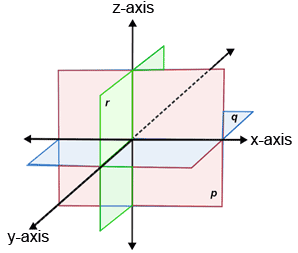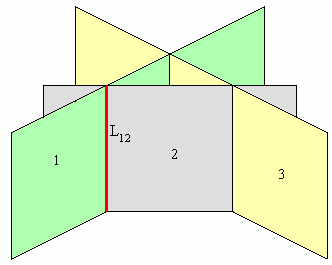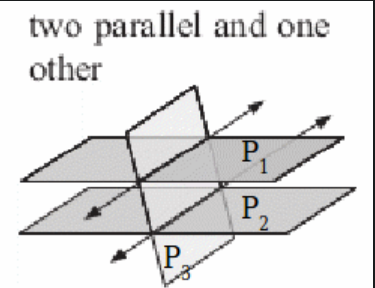Solving Systems of Equations using Matrices
Solving a simple simultaneous equation
- \(\begin{pmatrix}2x+2y \\ 3x-5y\end{pmatrix}=\begin{pmatrix}10 \\ -9\end{pmatrix}\)
- Rewritten, this gives us:
\(\begin{pmatrix}2 & 2 \\ 3 & -5\end{pmatrix}\begin{pmatrix}x \\ y\end{pmatrix}=\begin{pmatrix}10 \\ -9\end{pmatrix}\)
When we want to solve these, we want \(x\) and \(y\). - To solve this we can rearrange the matrices.
- \(\mathbf{A}x=\mathbf{B}\)
- \(\mathbf{A^{-1}A}x=\mathbf{A^{-1}B}\)
- \(\mathbf{I}x=\mathbf{A^{-1}B}\)
- \(x=\mathbf{A^{-1}B}\)
We can now apply these facts to our new matrix. - \(\begin{pmatrix}x \\ y\end{pmatrix}=\frac{1}{16}\begin{pmatrix}5 & 2 \\ 3 & -2\end{pmatrix}\begin{pmatrix}10 \\ -9\end{pmatrix}\)
- \(\frac{1}{16}\begin{pmatrix}50-18 \\ 30+18\end{pmatrix}\)
- \(\frac{1}{16}\begin{pmatrix}32 \\ 48\end{pmatrix}\)
- \(\begin{pmatrix}2 \\ 3\end{pmatrix}\)
The rule
If \(\mathbf{A}\begin{pmatrix}x \\ y \\ z\end{pmatrix}=\mathbf{v}\) then \(\begin{pmatrix}x \\ y \\ z\end{pmatrix}=\mathbf{A^{-1}v}\)
Applying this to a 3 unknown problem
- \(-x+6y-2z=21\)
- \(6x-2y-z=-16\)
- \(-2x+3t+5z=24\)
This can be written as: - \(\begin{pmatrix}-1 & 6 & -2 \\ 6 & -2 & -1 \\ -2 & 3 & 5\end{pmatrix}\begin{pmatrix}x \\ y \\ z\end{pmatrix}=\begin{pmatrix}21 \\ -16 \\ 24\end{pmatrix}\)
- The inverse of the 3x3 matrix is: \(\begin{pmatrix}\frac{1}{27} & \frac{4}{21} & \frac{10}{189} \\ \frac{4}{27} & \frac{1}{21} & \frac{13}{189} \\ -\frac{2}{27} & \frac{1}{21} & \frac{34}{189}\end{pmatrix}\)
- \(\therefore \begin{pmatrix}x \\ y \\ z\end{pmatrix}=\begin{pmatrix}\frac{1}{27} & \frac{4}{21} & \frac{10}{189} \\ \frac{4}{27} & \frac{1}{21} & \frac{13}{189} \\ -\frac{2}{27} & \frac{1}{21} & \frac{34}{189}\end{pmatrix}\begin{pmatrix}21 \\ -16 \\ 24\end{pmatrix}=\begin{pmatrix}-1 \\ 4 \\ 2\end{pmatrix}\)
- Therefore our answers are \(x=-1\), \(y=4\), \(z=2\).
Applying this to a modelling question
- \(1.02x+1.03y+0.96z=980\)
- \(x+y+z=1000\)
Putting into matrices:
\(\begin{pmatrix}1 & 1 & 1 \\ 1 & -1 & 0 \\ 1.02 & 1.03 & 0.96\end{pmatrix}\begin{pmatrix}x \\ y \\ z\end{pmatrix}=\begin{pmatrix}1000 \\ -100 \\ 980\end{pmatrix}\)
Inverting the 3x3: \(\begin{pmatrix}-7.384615385 & 0.5384615385 & 7.692307692 \\ -7.384615385 & -0.4615384615 & 7.692307692 \\ 15.76923077 & 0.07692307692 & -15.38461538\end{pmatrix}\)
\(\begin{pmatrix}x \\ y \\ z\end{pmatrix}=\begin{pmatrix}-7.384615385 & 0.5384615385 & 7.692307692 \\ -7.384615385 & -0.4615384615 & 7.692307692 \\ 15.76923077 & 0.07692307692 & -15.38461538\end{pmatrix}\begin{pmatrix}1000 \\ -100 \\ 980\end{pmatrix}=\begin{pmatrix}100 \\ 200 \\ 700\end{pmatrix}\)
What if the simultaneous equations never meet?
- If the simultaneous equations never meet then the matrix that defines them does not have an inverse. This means it is singular.
- This applies for all types of simultaneous equations, e.g. equations with 3 unknowns gives a point in 3d space. However this can not be visualised well with 4+ dimensions due to the 3d nature of reality.
3 variables, 3 dimensions
- In 3d space with 3 unknowns, a simultaneous equation with 3 unknowns will be visualised as a plane. (think like a sheet of paper).
- We get a solution when all 3 planes intersect with one another.
- The equation for a plane is: \(ax+by+cz=d\) instead of the 2 dimensional \(ax+by=c\) or \(y=mx+c\).

- This gives us a straight line

- This give a single point in space

- This forms a prism which has NO solutions. This means there is not point where all 3 planes intersect.

- Again, no solutions because there is no intersecting point. In this case it is because 2/3 planes are parallel.
How to write the conclusions
- If there is no point where the planes intersect, the system of equations is inconsistant.
- If there all intersect at one point and one point only, then the matrix is singular, otherwise it is always non-singular.
Finding the type of system
- If 2 equations are the same (e.g. \(x+y+z=1\) and \(2x+2y+2z=2\)) then these two planes are the same plane.
- If two equations are the same and have different final numbers (e.g. \(x+y+z=1\) and \(x+y+z=5\)) then these two equations are parallel.
- To find if a system makes a prism or a sheath we can subtract one eqaution from another to eliminate a variable.
- e.g. \(3x+6y-6z=-6\), \(-6x+3y+3z=2\) and \(-3x-y+3z=-2\)
- EQ1+2(EQ2) = \(-9x+12y=-2\)
- EQ2-EQ3=\(-3x+4y=4\)
- From this we can see that the equations are not multiples of one another, therefore they form a prism.
- If you eliminate \(z\) from all 3 equations using EQ1-EQ2, EQ2-EQ3 and EQ3-EQ1, and all 3 equations are multiples of one another then the equations form a sheath.